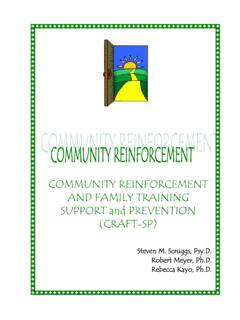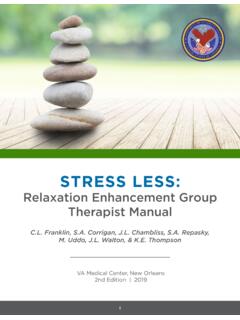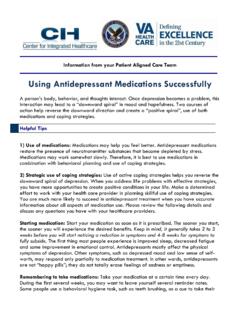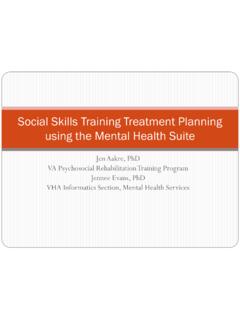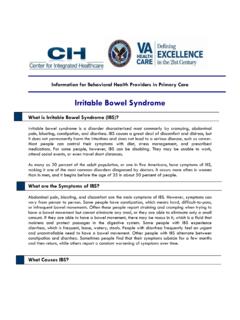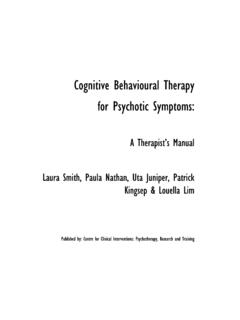Transcription of Cognitive Behavioral Therapy for Suicide Prevention
1 Cognitive Behavioral Therapy for Suicide PreventionPenn Center for the Prevention of SuicideGregory K. Brown, VA/DoD Clinical Practice Guideline for Suicide Prevention Webinar SeriesApril 27, 20211 Disclaimer and Disclosure Dr. Brown s views and opinions expressed in this presentation do not necessarily state or reflect those of the United States Government including the Department of Veterans Affairs and the Department of Defense. Dr. Brown receives royalties from the Research Foundation for Mental Hygiene for the commercial use of the Columbia Suicide Severity Rating the general approach, rationale and evidence supporting Cognitive Behavioral Therapy for Suicide Prevention (CBT-SP) specific Cognitive and Behavioral strategies for reducing a competency-based training for learning CBT-SP3VA/DoD Clinical Practice Guidelinefor the Assessment and Management of Patients at Risk for Suicide (2019)Strong recommendation for using Cognitive Behavioral Therapy -based interventions focused on Suicide Prevention for patients with a recent history of self-directed violence to reduce incidents of self-directed violence (p 27).
2 4 Conceptual Underpinnings of CBT-SP Suicidal behavior is viewed as the primaryproblem rather than a symptom of a disorder Cognitive Therapy for Suicide Prevention is viewed as an adjunctivetreatment Suicidal behavior is viewed as a problematic copingbehavior Treatment is briefand focused(10 to 16 sessions)5 Brown et al. (2005). JAMA, 295, Thoughts and Behaviors as Primary Functions for Repeat Suicide Attemptby Study ConditionCumulative SurvivalCT-SPControlDays*p< .05 Source: Brown et al. (2005). JAMA, 294, was associated with a 50% reduction in Suicide attempts in a severe sample with a high rate of repeat Cognitive - Behavioral TherapySoldiers in brief CBT were approximately60% less likely to make a Suicide attempt duringfollow-up than soldiers in treatment as : Rudd, Bryan, et al. (2015). AJP, 172, Therapy for Suicide PreventionWenzel, A., Brown, G. K., & Beck, A. T. (2009). Cognitive Therapy for suicidal clients: Scientific and clinical , DC: APA Books. Initial Phase Informed Consent Motivational Enhancement Suicide Risk Assessment and Narrative Timeline Interview Safety Planning Intervention (Stanley & Brown, 2012) Reasons for Living & Dying and Hope Kit Treatment Goals and Case Conceptualization Middle Phase Cognitive & Behavioral Strategies Case Management Strategies Final Phase Skill Consolidation Relapse Prevention Task Treatment Planning10 Problems with Treatment Engagement Individuals hospitalized for Suicide attempts often do not attend outpatient treatment.
3 Potential reasons include: Poor economic resources or practical barriers Negative attitudes toward treatment Feels hopelessness about getting better, won t be helpful Culturally-based beliefs about mental health treatment ( , don t talk about things like that; help should be found within family/church/community, etc.) Mistrust of mental health treatment Belief is common and validamong Black, Indigenous, people of color (BIPOC) populations due to discrimination and racism11 Assess Treatment Expectations Assess attitudes and expectations for Therapy : What do you expect Therapy to be like? Do you think Therapy will be helpful? How willing are you to attend a few Therapy sessions to see if it would be helpful? Discuss previous experiences in Therapy and how it contributed to any negative attitudes and expectations: What happened the last time you went to Therapy ? How was it helpful? How was it unhelpful? 12 Address the Risks of Treatment Possibility of emotional discomfort Discuss potential strategies that can be implemented should the client feel upset following a treatment session Potential negative effects of breaching confidentiality Collaborate around involving others (including emergency services) as a general rule Keep clients informed if confidentiality is broken in emergency situations where you were not able to discuss this first13 Case Management during CBT-SP Go the extra mile and reach out to patients Be flexible in scheduling appointments Make reminder and check-in calls Send birthday and holiday cards Discuss cases in regular team meetings.
4 Frequent use of consultation ( huddles ) to receive support14 Narrative Interview of Suicidal Crisis Obtain a detailed description of a suicidal crisis ( , recent attempt or recent moment when suicidal ideation increased) Patients are asked to recall the suicidal crisis in as much detail as possible, including the activating events and reactions to the events. Construct a timelinethat indicates the major external events and Cognitive , emotional, and Behavioral factors proximal to the crisis Forms the basis of the case conceptualization Understandthat suicidal thinking and behavior makes sense to the individual in the context of his or her history, vulnerability, and of Suicide Attempt: months ago, wife moves to Michigan w/ kids I never thought it would come to this. Commander laid into me and called me irresponsibleWhat do you do when everything is starting to fall apart?AngerHad a few beersDISTAL ACTIVATING EVENTAFFECTIVERESPONSEACTIVATING EVENTBEHAVIORAL RESPONSEKEY AUTOMATIC THOUGHTS KEY AUTOMATIC THOUGHTS 16 Timeline of Suicide Attempt: ExampleArgued with wife on phoneI can t take this anymore.
5 I don t know what to do. I m helpless. Maybe it would be easier if I ended it. Everything would be fixed. Put gun to chin and call from a friend interrupted the attemptOverwhelmedTold friend everything; went to his place and taken to clinic don t want to diePROXIMAL ACTIVATING EVENTAFFECTIVERESPONSEKEY AUTOMATIC THOUGHTS ( Suicide INTENT)REACTION TO SUICIDAL BEHAVIORBEHAVIORKEY AUTOMATIC THOUGHTS (MOTIVATION)SUICIDAL BEHAVIOR17 CBT-SP Focuses on Modifiable Risk Factors Case Conceptualization and Selection of CBT Strategies: Each treatment session addresses thoughts, beliefs, and behaviors that are most proximally related to the suicidal crisis and contribute to and maintain hopelessness. Select CBT-SP strategies that are perceived by boththe clinician and patient to be the most helpful in preventing a future suicidal Kit Identify and discuss reasons for dying and reasons for living Construct a Hope Kit or Survivor Kit to create a representation of reasons for living Pictures Letters Poetry Prayer Card Coping Cards Meaningful mementos or tokens19 Common CBT-SP Strategies Behavioral Activation Used to increase meaningful or purpose-driven activities, strengthen or enhance reasons for living, increase social connectedness, etc.
6 Cognitive Restructuring Used to help individuals to identify and evaluate Suicide -related thoughts; increase Cognitive flexibility. Coping Cards Used to remind individuals of important conclusions from Therapy that can be easily used in a Record ExampleDateSituationAutomatic ThoughtsFeelingsAlternative ResponseOutcomeWhat eventled to the unpleasant emotion? What thoughtswent through your mind?What emotionswere you feeling?Use questions to evaluate the emotion do you feel now? What will you do?12/18 Checked the mail Nothing but billsNo holiday cardsNo one would care if I was dead (95%)Sad (80)Lonely (90)Not many people send cards anymore. It doesn t mean people don t care. I got a call from my cousin the other day and Carlene invited me to Christmas dinner. They would take it really hard if I killed myself because they really do care. I believe the original thought 20% now. Not so down, actually, more optimistic (50)Still a little lonely (30)I ll call a friend and make Coping Card Automatic Thought: It s too much; it s over, there s nothing you can do about it.
7 Adaptive Response: Things have been bad before. You always come out of it better in the end. 22 Common CBT-SP Strategies Planful Problem Solving Used to help individuals brainstorm and evaluate potential solutions to solve problems without resorting to Suicide . Examine Pros and Cons Used to help individuals resolve ambivalence and make important decisions. ProsConsStaying on track in treatment; If I kill myself, treatment won t helpI would be giving in to what others tell me It would make my family feel betterI won t have it for protectionIt might make it more out of sight, out of mind Locking firearm in safe and giving key to Keats23 Review and Consolidate Skills Reviewing coping skills: Which skills were most helpful in reducing your suicidal ideation and desire for suicidal behavior? What have you learned through this experience? What further goals do you have for yourself? If the patient has difficulty generating a list of specific CBT coping strategies, then they may not be ready for the later phase of treatment Preparation for the Relapse Prevention Task24 Relapse Prevention Task Goals Rehearse coping with future crises.
8 Assess treatment progress. Determine if additional sessions are Suicidal CrisisReview Suicidal Crisis with SkillsFuture Crisis with SkillsDebrief and Follow-up123425 Age-adjusted Suicide Rates, by Sex: US, 1999-2019 Hedegaard et al. NCHS Data Brief. 2021 Feb;(398) Rates for Females by Age Group: US, 1999-2019 Hedegaard et al. NCHS Data Brief. 2021 Feb;(398) Rates for Males by Age Group: US, 1999-2019 Hedegaard et al. NCHS Data Brief. 2021 Feb;(398) Factors for Suicide Among Older Adults Older adults have a lower lifetime prevalence of Suicide attempts than younger adults Suicidal ideation is a major risk factor for death by Suicide for older adults Older adults often experience significant loss ( , death of partner, medical problems, independence, etc.) that increases risk Older men are often reluctant to disclose suicidal ideation to others Older men are likely to engage in passive suicidal behavior ( , failing to take prescribed medications) 29 Adapting CBT-SP for Older Men Greater focus on reducing suicidal ideation Treatment length was extended from 10 sessions to 16/20 sessions to address persistent ideation Pacing was slower.
9 Take your time! Used whiteboards to stay on the agenda and prevent drift Used worksheets and forms with LARGE FONTS Used post-it notes; laminate important information such as Coping Cards Provided written summary of the session and written homework assignment with rationale (reminders) 30 Cognitive Therapy for Suicidal Older MenAssessed for Eligibility(N = 332)Baseline Assessment(N = 110)Randomization(N = 95) Cognitive Therapy 16 Sessions(N = 46)Case Management 16 Telephone Sessions(N = 49)Follow-up Assessments 1, 3, 6, 9, 12 months(N = 34 completed 12M)Follow-up Assessments 1, 3, 6, 9, 12 months(N = 42 completed 12M)NIMH: R01MH086572-1A2, PI: Brown GK; : NCT0153548231 Inclusion desire or intent in the past month (SSI Items 4 or 5 >0) years of age or to provide informed to attend the study assessment and Therapy at least 2 verifiable contacts for tracking Functioning: MMSE => 24 and EXIT-25 <= 14 Exclusion priority treatment for a substance use disorder or PTSD antidepressant medication for less than four weeks or change in antidepressant medicationNIMH: R01MH086572-1A2, PI: Brown GK; : NCT01535482 Cognitive Therapy for Suicidal Older Men32 Demographics Mean age = (SD = ; Range = 50-80) Race: Black White Asian/Pacific Islander American Indian Other Ethnicity: 0% Hispanic/Latinx 95% were VeteransNIMH: R01MH086572-1A2, PI: Brown GK; : NCT0153548233 Columbia Suicide Severity Rating ScaleSeverity of Ideation Scale: Worst Point Since Last AssessmentNIMH: R01MH086572-1A2, PI: Brown GK; : NCT01535482b = ; p=.
10 02; 95% CI: to Suicide Severity Rating ScaleIntensity of Ideation Scale: Worst Point Since Last AssessmentNIMH: R01MH086572-1A2, PI: Brown GK; : NCT01535482b = ; p= .01; 95% CI: to Co-InvestigatorsKelly L. Green, PhDAaron T. Beck, MDDavid W. Oslin, MDMichael Thase, MDWarren Bilker, PhD Study TherapistsShari Jager-Hyman, PhDKristin PontoskiTaylor, PhDLaura Mowery, PsyDAbby Adler Mandel, PhDKeith Bredemeier, PhD Research PersonnelGabriela Khzanov, PhDAshley Bush, MMHJae S. Cha, PsyDPatriziaSalaniPlatt, MSEdGuy Weissinger, PhD, RNBridget Moran, MPHA riel Domlyn, MAPeter Awad, MAJennifer Greene, MSMichelle Gordon, MPHK aroline Myhre, MEd Special thanks to the VISN 4 MIRECC, CPL Michael J CrescenzVA Medical Center 36VA CBT-SP Telehealth Pilot Program Well Vets: CBT-SP for Veterans with Substance Use Disorders (N=300): RCT comparing CBT-SP vs supportive psychotherapy on Suicide outcomes over 2-year OMHSP: Pilot of CBT-SP using a telehealth hub and spoke model at VISN 10 and VISN CBT-SP Telehealth Pilot Program VA OMHSP SP Initiative: National telehealth expansion of Evidenced-Based Psychotherapies (EBPs) for Suicide Prevention Adapted CBT-SP for telehealth delivery with Drs.


